

“Limited” is the word to describe the 2020 Vintage Port declarations from Portugal’s Douro Valley. While the heat was up, the crop was down. The Instituto do Vinhos do Douro e Porto (IVDP) has approved 40 bottlings as of this writing, from 27 producers; even so, most producers announced their declarations with an emphasis on low yields and extreme selections.
The cycle began with plentiful rains at the end of 2019, providing water reserves for the vines. Rather than encouraging yields, however, those reserves were needed to sustain the vines as temperatures peaked above 105° F. in June. Extreme heat lasted through the month of July. Yields had already been diminished by a meager crop-set in spring and sunburned grapes cut them further. For many growers in the Douro, harvest was concentrated into the first three weeks of September, running early and fast, with all the varieties and exposures ripening within a tight timeframe.
The steep canyon walls of the Douro Valley and the river’s meandering course create one of the most intricate terroir puzzles in the world of wine. That diversity allows for success in conditions that may be severe or challenging overall. Dirk Niepoort decided against a declaration in 2020, as did Luis Sottomayor of Sogrape (there will be no Sandeman, Ferreira or Offley). But, for those with declarations, success on a small scale plays into the contemporary market for Vintage Port—or, at least, aligns it with the limited production of other coveted collectibles from Burgundy, Piedmont and California.
The two rows of vines at Nacional, Quinta do Noval’s own-rooted post-phylloxera experiment from the 1920s, often go their own way with vintages. Christian Seely, who has been managing director at Noval since 1994, states, “There are years when we know straight after the treading in lagar that we will be declaring a Nacional Vintage Port, and 2020 was one of these.”
At Vargellas, Taylor’s quinta in the Douro Superior, head winemaker David Guimaraens has no record of the hotter July (they started keeping track in 1931), but says that August temperatures were cooler than normal, followed by rain from August 17 to 20, a reset for the vines, which then raced their fruit to ripeness. Guimaraens compares the character of the wines to 2009 and 1820, both years with high sugar levels in the grapes. He produced 2,500 cases of Quinta do Vargellas, which managing director Adrian Bridge plans to cellar for late release.
For Charles Symington, winemaker at Symington Family Estates, the sweetness of the grapes played into the 200th anniversary of the founding of Grahams. In 1820, the sweet ripeness of the Port vintage caught the attention of William and John Graham, who received 27 barrels of Port that year to cover a debt to their textile business, convincing them to shift their focus to wine. For the Symingtons, 2020 is also the 350th anniversary of the founding of Warre’s. Charles, who has been actively playing with pairs of varieties in co-fermentations, blended his Graham’s Bicentenary bottling from several lots, including one co-fermented with touriga nacional and touriga franca, another pairing sousão and touriga nacional, a third combining a host of old mixed vines, and a fourth, singular alicante bouschet. He will release 250 cases this year. And 200 cases of Warre’s 350th anniversary bottling, from two parcels of old vines in field blends, their yields per vine one-third of normal.


For Jorge Rosas of Ramos Pinto, the freshness of the 2020 Vintage wine from Quinta da Ervamoira seemed paradoxical, considering the dry heat of the Douro Superior. The wine is a selection from three parcels planted by his father, José Antonio Ramos Pinto Rosas, in the 1970s. “One parcel has a north exposure,” he told me, “another a northeast. The exposure might have something to do with the freshness of the wine. For me, it’s promising, tranquilizing, when you think about global warming, in spite of the heat we are able to grow wines that are elegant and fresh at that quinta in the Douro Superior.”
Joshua Greene is the editor and publisher of Wine & Spirits magazine.
This story appears in the print issue of Summer 2022.
Like what you read? Subscribe today.

















